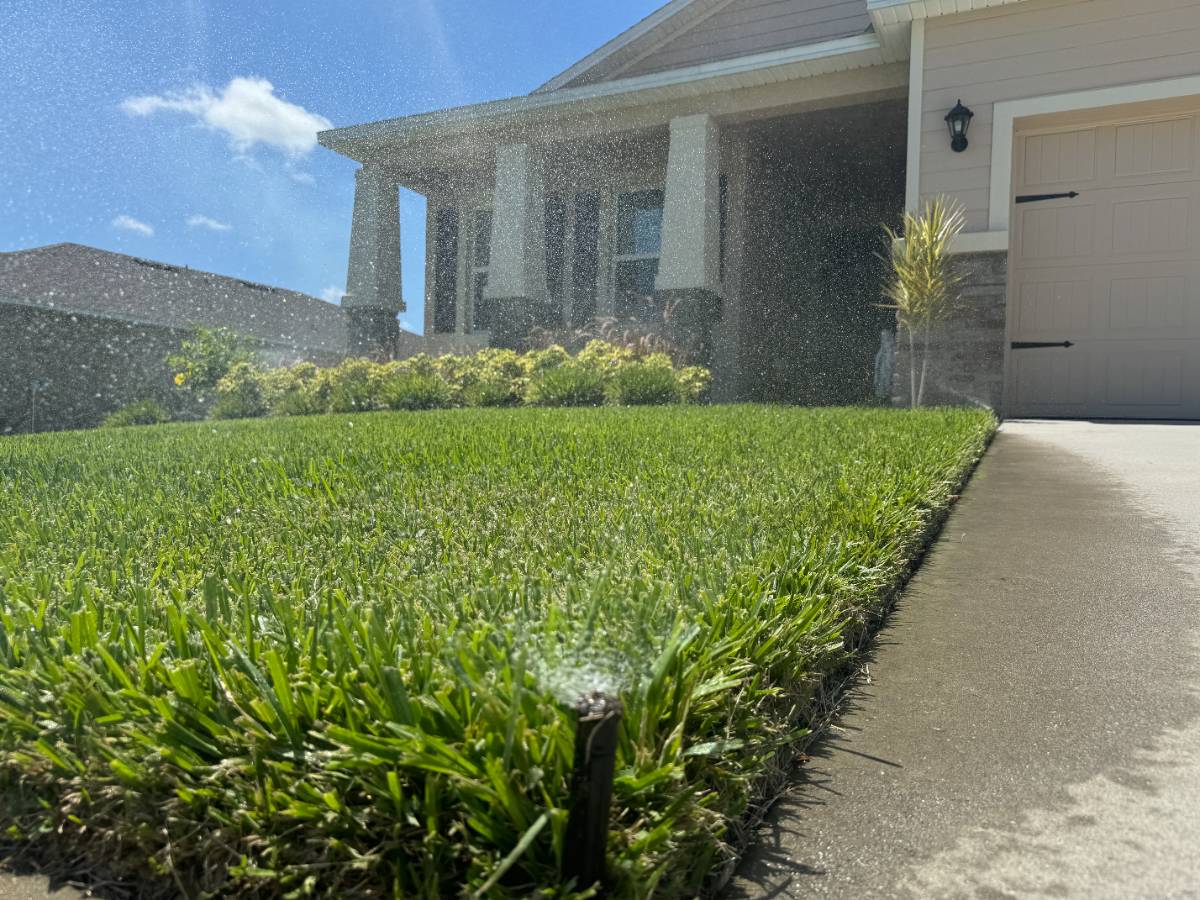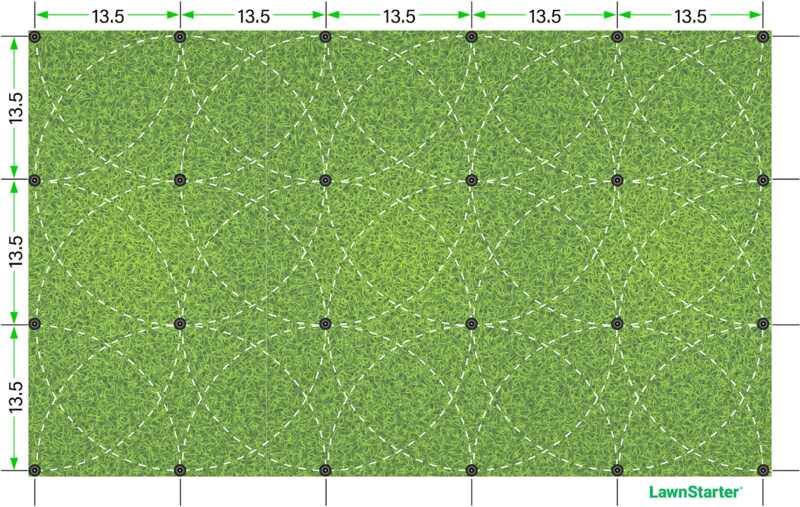
The weather can turn quickly here in Jacksonville, and your lawn feels every bit of it. One day it’s pouring, the next your grass looks like it hasn’t had a drink in weeks.
Most Jacksonville lawns need 1 to 1.5 inches of water, whether from rain or irrigation, spread over two sessions per week. Always water early in the morning to avoid the effects of evaporation in the searing midday sun.
In this article, we’ll talk about how and when to water your grass to keep it healthy and looking its best.
Watering Needs by Grass Type

Most Jacksonville lawns have warm-season grasses, which perform best in our hot summers and mild winters. Here’s how much water each type needs:
| Type of Grass | Watering Requirements (Per Week) |
| St. Augustinegrass | 1 to 1.5 inches |
| Zoysiagrass | 1 inch |
| Centipedegrass | 1 inch |
| Bermudagrass | 1 inch |
| Bahiagrass | 0.5 to 0.75 inches |
Follow this watering schedule only during the dry months, which run from the last week of October to early May. Jacksonville sees the highest rainfall from June to September, so cut back on irrigation during those months. Some weeks, you won’t even have to water at all.
See Related:
Water Early
The best time to water your Jacksonville lawn is in the early morning, between 5 a.m. and 7 a.m. because there’s less evaporation.
“The Florida heat is so strong in the afternoon that it will suck the moisture out of the ground before your lawn can get what it needs,” says Jacksonville lawn care pro Nicholas Hamilton.
Another reason is that grass wakes up thirsty, so it can absorb more water. You can stretch your watering until 8 a.m. to 10 a.m., but no later than that.
If you’re watering by hand or growing a new lawn, you can water in the evening from 5 p.m. to 6 p.m. It doesn’t violate restrictions, but the water stays on the blades for hours, increasing the risk of fungal diseases.
Water Deeply but Infrequently
It’s better to water your lawn deeply twice a week than to water it lightly every day. Deep watering encourages your grass to grow strong roots that help it withstand drought and heat. It also improves soil health.
Always check your soil and grass before watering your lawn. Overwatering does more harm than letting your turf dry out for a few days. It can cause fungal diseases and prevent grass roots from growing deeper into the soil.
Water only when at least 30% of the turfgrass shows signs of drought, such as:
- Grass blades folding up
- Wilting
- Grass turning blue-gray
- Footprints don’t disappear after you walk on the grass
I recommend watering your turf twice a week during the dry season. If it’s rainy, you likely don’t need to water at all, as the grass will get the inch of water it needs from rainfall.
Pay extra attention to the grass under trees, as trees tend to suck up most of the water coming their way. You can hand-water turf under your trees if needed.
Test Your Sprinkler Coverage

Place empty tuna cans around your lawn while watering to measure how much water your grass is receiving.
Turn on your sprinkler system for 15 minutes and check the level of water in the tuna cans. If there’s ¼ inch of water, you need to keep the sprinkler on for 30 minutes to apply ½ inch.
You should also measure the quantity of water in each cup to make sure the sprinklers spread water uniformly. If some cups have more or less water than others, check the sprinkler heads for clogs and adjust or reposition them for better coverage. Go for head-to-head spacing, where each sprinkler’s spray radius reaches the nearest sprinkler head. The image above demonstrates how.
Be Aware of Jacksonville’s Watering Restrictions
Jacksonville has year-round watering restrictions instituted by the St. Johns River Water Management District. These restrictions are designed to balance water conservation with homeowners’ needs.
When You Can Water Your Lawn
If you have an automatic irrigation system, you can water your lawn only on these days:
Mid-March to Beginning of November:
- Odd-numbered addresses and those without an address: Wednesday and Saturday
- Even-numbered addresses: Thursday and Sunday
- Non-residential properties: Tuesday and Friday
November to March:
- Odd-numbered addresses and those without an address: Saturday
- Even-numbered addresses: Sunday
- Non-residential properties: Tuesday
Regardless of the day, you can’t irrigate between 10 a.m. and 4 p.m., when the sun is strongest and water is more likely to evaporate. You can water your turf with only ¾ inch of water for an hour max.
When the Rules Don’t Apply

These restrictions don’t apply if:
- You hand water or use micro-spray, micro-jet, drip, or bubble irrigation systems.
- You’re using reclaimed water, recycled water, or water from heating and cooling systems.
- The irrigation system is being tested during maintenance or repairs, but only for a maximum of 20 minutes.
- You’re watering a new landscape, so you can irrigate daily for the first 30 days and then every other day for the next 30, if needed, to make sure it gets enough water.
Check out the City of Jacksonville’s homeowner’s guide for more information.
Use the Right Tools
You can save both water and time by using the right irrigation tools.
Sprinkler Head
Rotary nozzles are ideal for large areas, as they can spread 0.3 to 0.7 inches of water per hour in dense, rotating streams that evenly cover the lawn.
Spray heads work better for smaller or narrow areas, like those near patios or hardscaping that’s not intended to get wet. They disperse 1 to 2 inches of water per hour. Check out our article on the Types of Sprinklers for Your Lawn for more information.
Rain Sensor
Also called a rain shut-off device, it automatically stops your irrigation system during rain to prevent overwatering. Installing rain sensors is required by Florida Law (Section 373.62 F.S.).
Soil moisture sensors are a better choice as they measure how wet the soil is, so you can water your turf accurately. However, you should at least have a rain sensor installed to comply with the law.
Smart Irrigation Controller
Smart controllers adjust the watering schedule based on weather data and soil moisture. They are Wi-Fi enabled and can be operated through a mobile app. According to the UF/IFAS Extension guide, smart controllers can save 30% to 40% of water during dry conditions and 70% to 90% during normal Florida rainfall.
Check out our article on How to Install a Sprinkler System if you need help setting one up.
Improve Sandy Soil With Amendments

Jacksonville has Myakka soil, which is mainly sandy. It typically holds about an inch of water in the root zone, but you can improve that with organic amendments like:
- Compost: Decomposed organic waste that improves water-holding capacity and provides slow-release nutrients. It also protects the soil surface from wind and water erosion.
- Biochar: A charcoal-like material made by burning forestry and agricultural waste. It improves both water and nutrient retention. For best results, mix it with compost before topdressing your lawn.
- Mulch: Organic mulch like wood chips, grass clippings, or shredded leaves helps reduce evaporation and improve soil structure as it breaks down.
- Cover crops: Plant seasonal ground covers like ryegrass, clover, and oats during the off-season to improve soil structure, boost water retention, and reduce erosion.
Check out our article on How to Amend Sandy Soil for more information.
Mow at the Right Height
You may be wondering what mowing has to do with your watering strategy. Cutting your grass at the proper height encourages deeper root growth so it can easily access the ground’s moisture. Taller grass blades also shade the soil, reducing water evaporation.
Here’s the recommended mowing height for the popular grass types in Jacksonville:
| Type of Grass | Recommended Mowing Height |
| St. Augustinegrass | 2 to 3 inches |
| Zoysiagrass | 1 to 2 inches |
| Centipedegrass | 1 to 2 inches |
| Bermudagrass | 1 to 2 inches |
| Bahiagrass | 3 to 4 inches |
FAQs
Yes, you can hand water your lawn with a hose or use micro-spray irrigation at any time of day. The restrictions only apply to automated sprinkler systems.
Yes, winter in Jacksonville lasts from December through February, and these are also among the driest months. Water your lawn only when at least 30% of your grass shows signs of drought, such as folded blades or lingering footprints. You may only need to water every other week.
For more about maintaining Jacksonville lawns, check out these articles:
• Summer Lawn Care Tips for Jacksonville
• 10 Spring Lawn Care Tips for Jacksonville
• Fall Lawn Care Tips for Jacksonville
• Winter Lawn Care Tips for Jacksonville
Keep Your Jacksonville Lawn Healthy and Fresh

Proper watering is key to a great lawn, but it’s not enough. It needs good mowing, fertilization, aeration, dethatching and other services. LawnStarter’s Jacksonville lawn care pros have you covered.
We also have local lawn care pros in Middleburg, Jacksonville Beach, Orange Park — and all across the Jacksonville metro area. Call, click, or book mowing in our app.
Main Image: A sprinkler waters a St. Augustinegrass lawn in North Florida. Photo Credit: Tom McNiff / LawnStarter